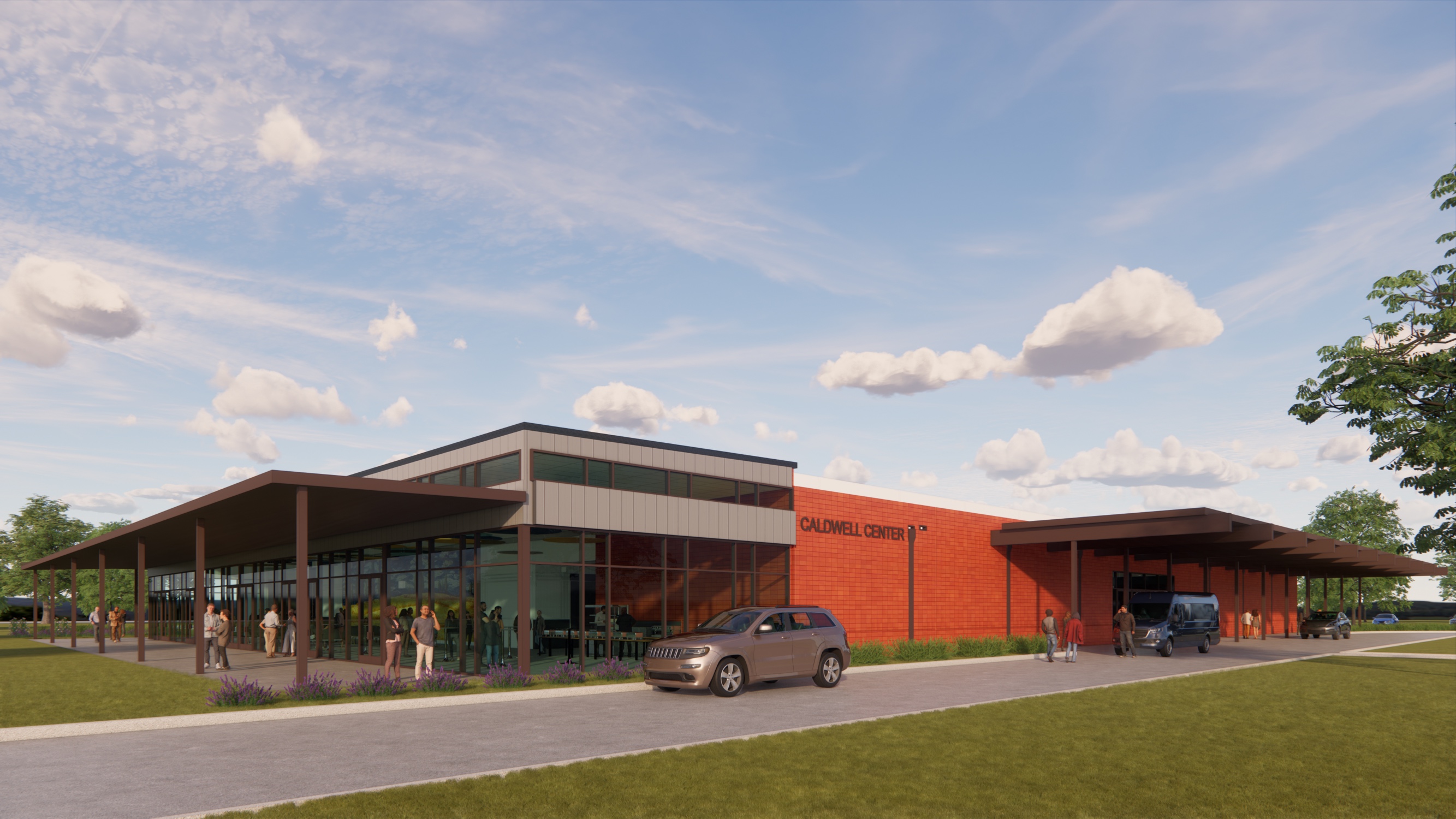A new 45,000 sf FEMA-operated evacuation shelter in the Greater Austin metropolitan area will begin construction this fall. The center will be available to house people in the event of a disaster such as a major hurricane and double as an events venue when not needed for emergency shelter.
The Caldwell County Evacuation Center will house up to 350 people comfortably within its main hall. Supply trucks can deliver necessities to the back of building which includes designated office space to accommodate FEMA operations and a warming kitchen where food will be served. Overlooking the sweeping natural landscape, an elevated outdoor patio and adjacent interior concourse will function as a breakout space for events and a provide outdoor connectivity for evacuees.
Warm tones and wood accents will be incorporated throughout to combat the stale environment often seen in evacuation shelters. Elevated fixtures and details will be included in the restrooms such as floor-to-ceiling partitions between each stall and individual shower rooms for an increased sense of privacy and space. Families seeking shelter with young children will also have three designated mothers’ rooms to choose from for nursing and pumping, as well as extra changing tables in both the women’s and men’s restrooms.
Extra charging outlets will be deployed in the corridors and common spaces to help decrease congestion in the main hall and encourage evacuees to explore alternative spaces with natural light and outdoor views. Acoustic measures in the ceiling and wall panels will be integrated to help mitigate noise throughout the building, not only for functional purposes but also to reduce overstimulation when the building is at capacity.
The facility is likely to host residents of coastal areas of the state during hurricane emergencies. Damaging hurricanes have become more common in Texas, with eight of the 10 most active years occurring since the mid-1990s. These storms have impacted thousands of coastal area residents. Hurricane Harvey, for example, displaced approximately 32,000 people in shelters across the state. Inland areas such as the Austin metroplex can provide temporary shelter for these residents.
Owner and/or developer: County of Caldwell
Design architect: Method Architecture
Architect of Record: Method Architecture
MEP Engineer: IMEG
Civil Engineer: Doucet, a Kleinfelder Company
Structural Engineer: IMEG
Landscape Architect: Coleman & Associates
Grant Administrator: Langford Community Management Services
General Contractor: N/A
Related Stories
Resiliency | Oct 29, 2024
Climate change degrades buildings slowly but steadily
While natural disasters such as hurricanes and wildfires can destroy buildings in minutes, other factors exacerbated by climate change degrade buildings more slowly but still cause costly damage.
Resiliency | Oct 17, 2024
U.S. is reducing floodplain development in most areas
The perception that the U.S. has not been able to curb development in flood-prone areas is mostly inaccurate, according to new research from climate adaptation experts. A national survey of floodplain development between 2001 and 2019 found that fewer structures were built in floodplains than might be expected if cities were building at random.
Resiliency | Sep 3, 2024
Phius introduces retrofit standard for more resilient buildings
Phius recently released, REVIVE 2024, a retrofit standard for more resilient buildings. The standard focuses on resilience against grid outages by ensuring structures remain habitable for at least a week during extreme weather events.
Curtain Wall | Aug 15, 2024
7 steps to investigating curtain wall leaks
It is common for significant curtain wall leakage to involve multiple variables. Therefore, a comprehensive multi-faceted investigation is required to determine the origin of leakage, according to building enclosure consultants Richard Aeck and John A. Rudisill with Rimkus.
Products and Materials | Jul 31, 2024
Top building products for July 2024
BD+C Editors break down July's top 15 building products, from Façades by Design to Schweiss Doors's Strap Latch bifold door.
Codes and Standards | Jul 22, 2024
New FEMA rules include climate change impacts
FEMA’s new rules governing rebuilding after disasters will take into account the impacts of climate change on future flood risk. For decades, the agency has followed a 100-year floodplain standard—an area that has a 1% chance of flooding in a given year.
Adaptive Reuse | Jun 13, 2024
4 ways to transform old buildings into modern assets
As cities grow, their office inventories remain largely stagnant. Yet despite changes to the market—including the impact of hybrid work—opportunities still exist. Enter: “Midlife Metamorphosis.”
Resiliency | Jun 3, 2024
Houston’s buyout program has prevented flood damage but many more homes at risk
Recent flooding in Houston has increased focus on a 30-year-old program to buy out some of the area’s most vulnerable homes. Storms dropped 23 inches of rain on parts of southeast Texas, leading to thousands of homes being flooded in low-lying neighborhoods around Houston.
Resiliency | May 24, 2024
As temperatures underground rise, so do risks to commercial buildings
Heat created by underground structures is increasing the risk of damage to buildings, recent studies have found. Basements, train tunnels, sewers, and other underground systems are making the ground around them warmer, which causes soil, sand, clay and silt to shift, settle, contract, and expand.
Adaptive Reuse | May 15, 2024
Modular adaptive reuse of parking structure grants future flexibility
The shift away from excessive parking requirements aligns with a broader movement, encouraging development of more sustainable and affordable housing.

















